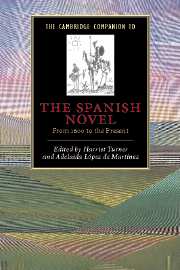Book contents
- Frontmatter
- 1 On the novel: mirror and text
- Part 1 Since Cervantes
- Part 2 The nineteenth century
- 4 The regional novel: evolution and consolation
- 5 The folletín: Spain looks to Europe
- 6 The realist novel
- 7 History and fiction
- 8 Gender and beyond: nineteenth-century Spanish women writers
- 9 Decadence and innovation in fin de siglo Spain
- Part 3 The twentieth century
- Bibliography
- Index
- Series List
6 - The realist novel
from Part 2 - The nineteenth century
Published online by Cambridge University Press: 28 May 2006
- Frontmatter
- 1 On the novel: mirror and text
- Part 1 Since Cervantes
- Part 2 The nineteenth century
- 4 The regional novel: evolution and consolation
- 5 The folletín: Spain looks to Europe
- 6 The realist novel
- 7 History and fiction
- 8 Gender and beyond: nineteenth-century Spanish women writers
- 9 Decadence and innovation in fin de siglo Spain
- Part 3 The twentieth century
- Bibliography
- Index
- Series List
Summary
When we think of realism in fiction, we think first of mimesis – the imitation of life – a concept that at once implies the existence of something outside the writer's own mind which he or she is trying to imitate. The imitation of this supposedly external “thing” undergirds the term “realism,” whether applied to painting, philosophy, literature, or film. As Harry Levin reminds us, “Etymologically, realism is thing-ism. The adjective 'real' derives from the Latin res [meaning 'thing'] and finds an appropriate context in 'real estate'” – land, property, things. The realist novel in Spain places a special emphasis on this primary engagement with the things of this world. In this emphasis, nineteenth-century Spanish realism harks back even to the epic Poema de Mío Cid (1140), in which a close-up focus on things – cages laid bare, emptied of hunting falcons, weeds growing on the threshold of an abandoned castle – participates vividly in telling the story of exile.
Writing in this realist tradition, Benito Pérez Galdós (1843–1920), in his1870 essay on the art of the novel, first evokes the principle of mimesis. Hisstated aim is to reproduce life as objectively as possible, depicting things asthey “really” are – houses, dress, furniture, gestures, and habits of speech. Ina later essay (1897) he affirms that language itself constitutes the most tellingsign of personal and national identity.
- Type
- Chapter
- Information
- The Cambridge Companion to the Spanish NovelFrom 1600 to the Present, pp. 81 - 101Publisher: Cambridge University PressPrint publication year: 2003
- 1
- Cited by



